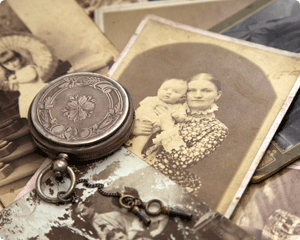Are you curious about where you came from or want to know more about your family history? There are many amazing stories out there just waiting to be discovered, but how do you get started? There's no question that doing your genealogy research can be daunting. There are many lines and connections and so many questions to ask. Where do you go to find your relatives? What type of information should you look for? How do you know that the information is accurate? What if you run into roadblocks? So many questions, but you don't need to worry. Just take it one step at a time.
The following tips can help you get started with your family search. There are websites like www.ancestry.com that can help, but there are also plenty of ways to get started for free. Having some knowledge with the use of a computer will help speed up you research and will also be the most effective way to do it.
1. Family Tree Chart
The very first place to start is to write down what you know about your parents, grandparents, and great-grandparents using a 4-generation pedigree chart or "family tree". You can download a free Family Tree Chart from Vertex42.com. As you do your research, you can print and link more of these charts together. I'd recommend saving an electronic copy as well as printing the family tree charts to keep in a binder or journal. You'll probably use several sheets. This is a good way to summarize the information you find. Sometimes you may only have a first or last name, but add it anyway. Whatever information you can find now can help you later.
For more detailed information about a family, such as recording the information about all your uncles and aunts, use a family group sheet.
2. Talk to Your Family
Do you know family members that have any useful resources? Maybe you have a family member that has already done this research? Your family may also know oral stories that have been passed down. Other typical resources could include a family Bible (that has names and important dates recorded in them), old photographs, journals, letters and family artifacts.
3. Check Out FamilySearch.org
This is the largest genealogical organization in the world. It contains several names, records and other resources and services. It is an organization established by the Church of Jesus Christ of Latter-day Saints. You can access the available information right from your home by going online to www.familysearch.org. There are several sites to visit in person around the world. The largest onsite location is in Salt Lake City, Utah, but there are other satellite locations with specialists that can help answer questions.
4. Census Records
The U.S. Census was established when the country was founded so that states could know how may U.S. Representatives should represent the state (based on population). A census has been taken every 10 years starting in 1790. Usually, the census is taken by head of household or the widow of the home. Federal laws try to protect privacy by only making records that are dated 72 years or older. Users can access census information from 1790-1930. The 1940 census report will be available April 2012. Records for the 1890 census are more difficult to come by because a fire broke out in the building they were kept in. The census shows the head of household, those living in the home at the time, approximate ages, where born and other useful personal information. Other countries also have census records, but they may be different than the U.S.
Census records can be accessed for free at sites like FamilySearch.org and Heritage Quest (a program usually available through your public library). You can pay for records through ancestry.com and through other public record services. Census records are very accessible and you may find you can get all the information you need for free with FamilySearch or Heritage Quest. [Edited 7/19/11]
5. Other Useful Records
Do you have (or know someone who has) access to birth, marriage, death, divorce, adoption, military, medical and other useful records. These types of primary sources often contain the most accurate information. They can help give information about who, what, where and how. If you have lived in an area for a while or can get to the area where some of your family originates, courthouses are one place you can find this type of information. Adoption papers are helpful for those looking for their birth relatives.
6. Google It
Try using Google or an appropriate search engine in order to find results. You may be surprised with the information you can find using this tool. The more detail and focus you can provide to your search the better the results will be.
There is a huge ongoing effort to digitize documents, books, and other records related to history and family history, because doing so makes it hundreds of times easier to search. Searching online will often get you information from cemeteries as well as link you to places where other researchers have published their findings. You might be surprised at how many other people you don't even know are researching your same lines.
7. Libraries
Never underestimate libraries. I once looked for a relative who was killed by a bandit. There wasn't much information from any known family members, so I contacted a few libraries in areas I knew this relative had lived. I finally found a library that could provide me some resources printed at the time of this family member's death. It was a great help.
8. Newspaper Articles and Obituaries
As my above mentioned example illustrates, articles can be useful. Much of what the library sent me about the family member killed by a bandit was from newspaper articles from the time of the event. Certain online newspaper sources might cap how far back they go with archives, but libraries or other community centers may store copies of old newspapers.
Obituaries provide a lot of information in a short space. You can definitely get names and important dates, but the next of kin is also usually listed which might allow you to get in touch with relatives who can provide additional information. But don't go calling people if the obituary was recent. A lot of obituaries can be accessed for free through online newspapers. Many of these papers have an archives section that will list the departed many years back.
9. Cemeteries
Cemeteries not only help you verify names and dates, but they can also help you find information about a spouse and other family members who might be buried nearby. Interment.net is one website that might help you in your search.
10. Social Security information
If you're looking for a more recent deceased ancestor in the U.S., the Social Security Death Index website can be very useful. Social Security numbers can be an excellent primary source. This index only lists the information recorded since 1962.
In summary ...
These are just a few of the things you can do to get started on your family history search. There are many free resources available, and it's usually pretty easy to find information about your more recent ancestors. It gets more and more challenging as you delve further back in time, but that's part of what makes it such a fun and rewarding hobby!




Comments
Great list! A comment about census records, though. Census records can usually be accessed for free, often in your own home. Check with your local public library to see whether they have a subscription to Heritage Quest. If they do, they will provide you with the information you need to use that at home.
KYN, always looking for KYNfolk!
Hi Karla,
Thanks for pointing this out. I didn’t mention it because I haven’t used Heritage Quest as much and because I believe familysearch.org is the largest free online source out there, but Heritage Quest does have a good reputation and I think all (or at least most) public library have access to it and if you have a local library card, I believe it can be accessed from home.
I should correct the language a little bit in that paragraph. MY point was that you can obtain the census records for free through programs like familysearch.org, but if you use ancestry.com or even some government sites, that you pay for those, but actually, there really is no reason to not get most census information for free using these resources mentioned.
Thanks again. Good luck with your genealogy searching.
Hi, thanks for the great resources. I used the search engine familysearch.org and it is awesome! I’ve been trying to find info. on my great grandfather b/c no one(meaning my dad) seems to know much about him besides his name and that he left when my grandpa was very young. I don’t know if he just abandoned his family, died or what? I managed to find a marriage license for he and my great grandma, but that’s it no census reports or nothing pertaining his name or birth certificate. I just wanted to know if you have any other ideas to help me solve this family mystery. Thanks.
@Sheena–At least you have a name which is a good start. This can happen with family history (not having much info that is). Do you know where this relative lived? Sometimes you can check with the libraries and they may have an obituary or articles on them. If you have a name and even a place they live you could check the cemetery website listed and it may show where he’s buried at. Do you have any other living relatives (grandparents, aunts, uncles) that may have known anything about him? That could be another source to get some info. Even if your Dad doesn’t know much, it doesn’t mean other relatives don’t. I hope that helps. Good luck in solving the mystery.
I actually tend to go along with every little thing that is authored within “Free family tree template, genealogy search, family history search”.
Thanks a lot for pretty much all the actual info.
Thanks,Anita
This is pretty cool. I am actually looking for some kind of template to use that would help me keep track of all the information I have to aid me in searching for the missing information for the ancestors in my tree. I thought of doing something with excel, but hoped that someone had already done something like that…..
For some reason, I can’t get the 6-generation Family Tree to open. The tree appears but Ii cannot insert ay information. What am I doing wrong?
Carol, assuming you are using Excel to open the spreadsheet file … make sure it is not “Read-Only” at the top. Download the file, then open in Excel rather than opening in a spreadsheet viewer. Also, you may need to click on the yellow notice in Excel if one pops up asking if you want to allow editing. Difficult to provide more specific answers without specific details.
Finally, I used a Census Tracker a number of years ago. Unfortunately, my computer crashed and I neglected to back up ALL my files, the tracker being one of them. I was able to recreate some of the spreadsheets but they weren’t quite up to what I was using. Finally found this, THANK YOU. Do you happen to have one for 1790 (I go back pretty far)
@Frank … I don’t have a census worksheet for 1790. You could make a copy of one of the other census worksheets and the modify labels as needed.